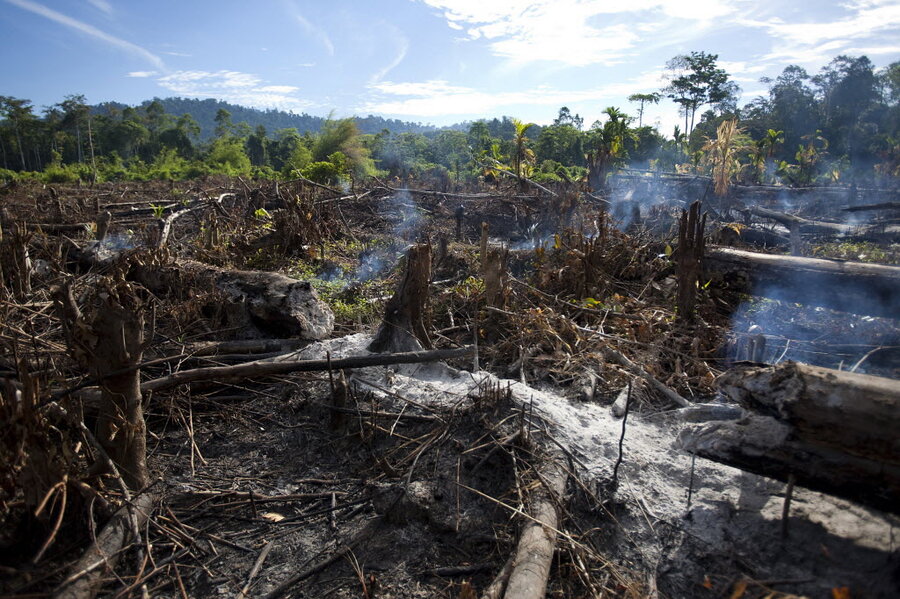Study: Loss of Indonesia's pristine (and carbon-storing) forests is rising
Loading...
Indonesia is losing its most pristine forests at an increasing pace, a trend that is depriving humanity of a vital natural ally in efforts to limit the impact of global warming.
These Indonesian forests – important not only for the carbon they store but also for their biological richness – shrank by 38 percent between 2000 and 2012, according to a detailed analysis of images from US Landsat satellites. That's 24,000 square miles of timber.
The research covers changes to mature, natural forests where no clearing has yet taken place or where the forest has been used to a certain degree but still stores vast amounts of carbon and hosts significant biodiversity. Both fall into the study's definition of primary forest.
Some 98 percent of the loss occurred in primary forests that have been somewhat degraded, according to the analysis, led by Belinda Margono, a graduate research assistant at the University of Maryland at College Park on leave from the Indonesian Ministry of Forestry. Some 40 percent of the losses came from forests where clearing forests either is under tight restrictions or is illegal.
Throughout the period, the rate at which Indonesia lost primary forests increased, reaching 3,200 square miles a year for 2012 – a year after the government imposed a moratorium on felling trees in primary forests. The 2012 loss was nearly double the area that Brazil lost the same year, according to the study.
Indeed, Brazil has made enormous strides in reducing deforestation during the past eight years, researchers note, although it saw an uptick in forest losses in 2013. Still, Indonesia's losses have shot past those of Brazil, which historically has had the highest rates of tropical-forest losses. And Indonesia has only about one-quarter of the area of Brazil's forests.
Moreover, losses in Indonesia are increasing in primary forests growing in and around wetlands, whose peat represents a huge pool of stored carbon – carbon released when the forests are cleared and the wetlands are drained to make way for industrial-scale agriculture. Dry peat also is prone to fires, which can smoulder or burn for years below ground and touch off forest fires above ground.
"It's brutal," says Matthew Hansen, a professor of geographic sciences at the University of Maryland and a member of the research team reporting the results published online by the journal Nature Climate Change this week. "The news is bad, right down the line."
Deforestation can have a profound effect on greenhouse-gas emissions. In 2011, Indonesia was the 10th largest source of greenhouse-gas emissions (if the contribution from deforestation and other land-use changes is omitted), emissions data gathered by the World Resources Institute show. When land-use changes are included, Indonesia rose to No. 7.
In China, the US, Europe, India, and Russia, forests reduced overall greenhouse-gas emissions from burning fossil fuel and producing cement.
The study grew out of work Dr. Hansen and colleagues published in November that used data from Landsat satellites to reveal a net decline in global forest cover of about 580,000 square miles between 2000 and 2012. At the time, Hansen and his colleagues highlighted Brazil's declining losses and Indonesia's increasing losses.
But forest cover is a broad gauge; by itself it doesn't distinguish between primary forests and tree farms, nor does it distinguish losses to logging or farming from losses to wildfire or disease.
Other researchers, as well as the Indonesian government, used the "brush too broad" argument to push back on the results. This prompted Ms. Margono's team to dig more deeply into the Landsat data to see what they held for Indonesia. Poring over Landsat pixels, she broke down forests by general location – wetlands, lowlands, and mountains – as well as by the the Indonesian government's forest-use categories.
"This is an incredible amount of detailed work," says Doug Boucher, director of climate research and analysis for the Union of Concerned Scientists in Washington, who focuses on looking for ways to reduce deforestation and other land-use changes that contribute CO2 emissions to the atmosphere.
"Unfortunately, it will be necessary for some countries," as tropical-forest conservation and even reforestation become more deeply ingrained in a new global climate agreement, currently being negotiated with an aim toward including all countries in efforts to apply the brakes to human-triggered climate change.
"Indonesia is one of them," he adds, noting a disconnect between what Indonesia officially reports and what is happening on the ground.
Official Indonesian numbers indicate that deforestation in primary forests declined between 2000 and 2012. But the Margono-led analysis indicated otherwise and dovetails with trends shown in the UN Food and Agriculture Organization's 2010 Forest Resources Assessment.
The government is serious about curbing deforestation, says Fred Stolle, a senior analyst at the World Resources Institute in Washington, who has been working with the Indonesians on forestry issues.
Even so, the issue pits the nation's forestry and agriculture ministries against the environment ministry. And local enforcement is spotty.
Although Indonesia has overtaken Brazil in annual forest losses, Margono and colleagues caution that Brazil may be on the verge of reversing its remarkable success.
Revised regulations adopted two years ago, for instance, allow landowners to clear riverbanks and hillsides that previously had been protected, even as they impose tighter requirements on landowners to report the forested extent of their holdings. Brazil's lead public defender reportedly has filed 39 challenges to 39 provisions of the regulations, arguing that they fly in the face of the government's obligation to protect the environment.








